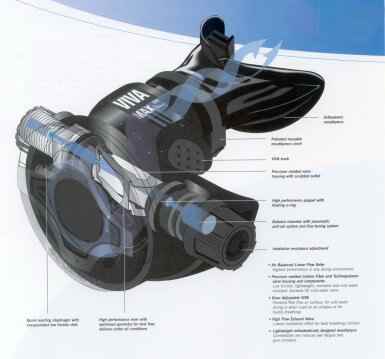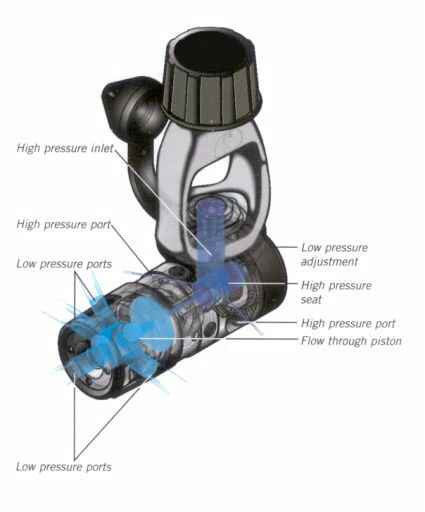|
|
|
What makes a
Regulator Work? Conventional downstream piston first stage. This type of first stage regulator is the benchmark of simplicity and reliability. The piston is the only moving part in this low maintenance first stage. Before the tank is opened, the piston is down in the chamber and the piston is in the open phase. When pressurized, the intermediate pressure air flows to the piston head through the piston cavity to thrust the piston against the spring and close the valve. When inhalation begins, the pressure is revived behind the piston head and the spring reopens the piston allowing air to flow. This cycle is repeated consistently hundreds of times during the dive, opening and closing one time for each breath. This first stage, originally designed more than 40 years ago, is a true classic and remains virtually unchanged. It equips most scuba schools throughout the world, successfully working in a variety of configurations. Diaphragm first stage. Diaphragm-based first stages, by virtue of their environmentally sealed design, have been longtime favorites of cold water divers and those working in water containing a high degree of suspended particles, silt, or other contaminating materials. Diaphragm first stages come with an balanced-diaphragm technology which incorporates a pneumatically-balanced, high pressure seat design that withstands delamination along with a short-throw lifting pin that reduces mechanical drag. The result is a first stage system that responds to extremely fast flow requests from the second stage. Balanced Piston first stage. Balanced piston first stages are generally the highest performing regulators made. First because the balanced piston is unaffected by changes in pressure, the piston regulator can deliver a consistent air flow to the second stage regardless of changes in tank pressure. Second, because the piston design creates a more direct air path through a bigger bore air passage, this regulator is able to deliver significantly higher quantities of air on demand. Consequently, instead of an
increase of breathing resistance towards the end of the dive (as in standard
first stage designs) or no change throughout the dive (as in balanced first
stage designs), the balanced piston regulator makes breathing easier as the dive
progresses. This feature is called over-balancing. Venturi-Initiated Vacuum Assist. The amount of inhalation or demand effort is actually divided into two distinct components. The most obvious is the initial effort or exertion required to open the valve and start the flow of air. The second effort is the amount of energy required to maintain the air flow after the valve is opened. This is referred to as flow resistance To reduce flow resistance the venturi-intiated vacuum assist is used. A high-velocity air stream pulls air molecules inside the second stage casing, which generates a vacuum behind the diaphragm. As the diaphragm draws further inward, it depresses the lever which maintains the poppet open for a "power assist" breath. The venturi-intiated vacuum assist is usually adjustable by a flow vane that can be positioned on the minimum position to minimize free flow in specific diving conditions such as shore diving water entry or practicing buddy breathing. Or to the maximum position to greatly reduced breathing resistance. Classic
downstream valve second stage. Classic downstream valve second stages are particularly noted for their legendary safety and reliability. In operation, a downstream valve opens in the same direction as the incoming air flow from the first stage. This incoming air exerts a force on the end of the poppet that pushes the valve into the open position (downstream). This force is counteracted by a spring that pushes the poppet in the opposite direction (upstream) toward the closed position. Inhalation effort required to open a downstream valve is directly proportional to the resistance of this spring. Air
balanced linear flow valve second stage. A regulator second stage must translate natural breathing reactions into mechanical reality. The quality of this human-to-machine interface is one of the most critical elements of the diving experience. A high quality second stage can significantly reduce stress and enhance diver safety by providing smooth, low-effort breathing response that results in ample yet controllable quantities of air. Balancing reduces the spring tension required to hold the flow valve closed, while maintaining sufficient pressure to allow for the safety of a downstream override. Because spring tension in this configuration is one of two causes of inhalation resistance, the smaller, lighter spring used can provide the lowest possible inhalation effort. The result is an ultra-high air flow that remains exceptionally stable under all breathing conditions.
|









